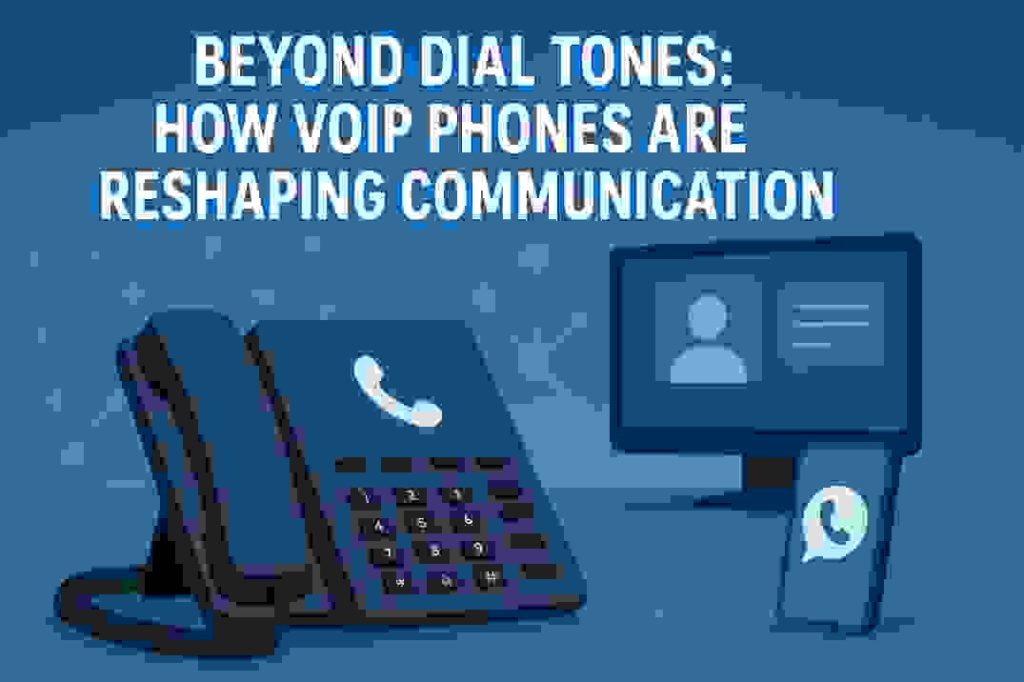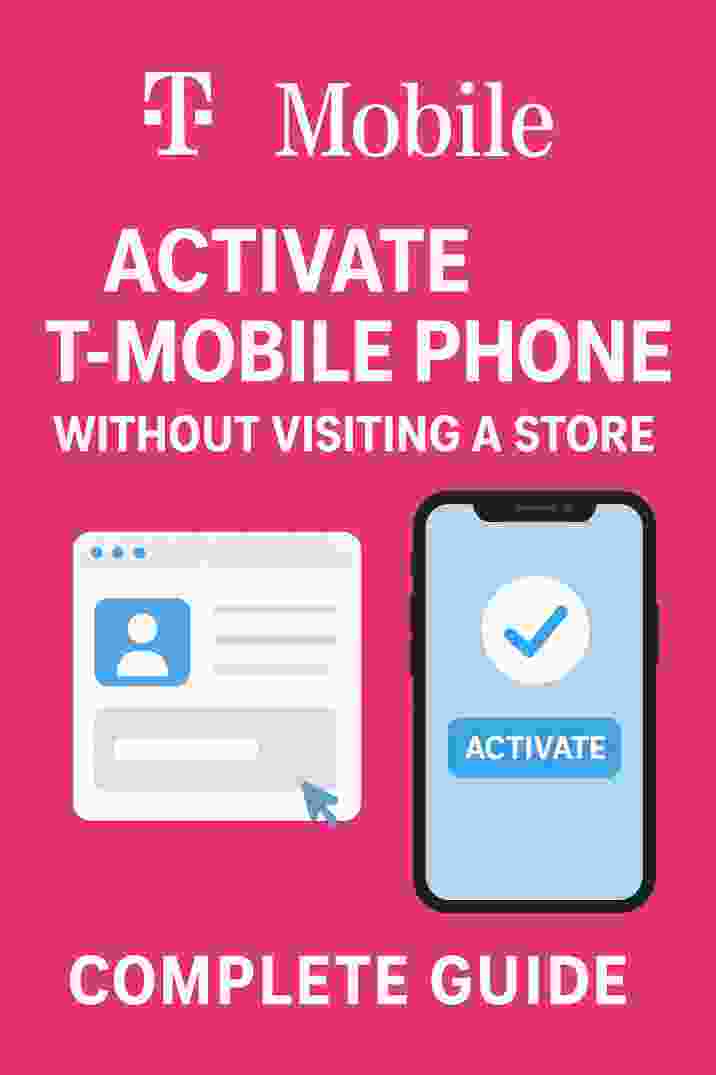A modern VoIP desk phone on a networked server rack, illustrating advanced VoIP communication technology.
In the digital age, the humble VoIP phone (Voice over Internet Protocol) has become the linchpin of modern connectivity. By converting voice into data packets and sending calls over the Internet, VoIP systems unify voice, video, and messaging into one seamless platform. Market analysts project the global VoIP market will grow from about $132.5 billion in 2023 to over $326 billion by 2032. This transformation eliminates bulky copper lines and expensive PBX hardware, enabling businesses to significantly streamline communication. VoIP phones have become catalysts for a global communications makeover.

What Is a VoIP Phone?
A VoIP phone is a device (or software app) that uses your broadband Internet connection to make and receive calls instead of a traditional phone line. Your voice is digitized and sent as Internet packets. For example, a business phone provider explains that VoIP “makes and receives high-quality calls” while eliminating the need for physical line installation and maintenance. This means companies no longer require dedicated copper wiring or costly landline infrastructure.
Importantly, VoIP phone services come with virtual phone numbers that aren’t tied to a specific cable or location. When you sign up, the provider assigns you one or more VoIP phone numbers that route calls over the internet. Thanks to number portability, you can often keep your existing local or toll-free number. As one guide notes, porting a number to VoIP is “a lifesaver” for brand continuity, since customers can still reach you at the same familiar number. In effect, a VoIP phone number behaves like any other number but with the flexibility and features of cloud telephony.
Key Benefits of VoIP Phone Systems
Modern VoIP phone systems offer strategic advantages over traditional phones:
- Significant Cost Savings: Internet-based calls eliminate long-distance fees and reduce maintenance. Businesses often report cutting phone costs by 30–50% or more after switching to VoIP. Startups, in particular, see massive savings – one study found new companies can slash their initial telecom expenses by up to 90% by choosing VoIP over hardware phones. By bundling voice, video, and data, VoIP avoids separate charges and reduces on-site equipment needs, leading to substantial telecom budget reductions.
- Advanced Features & Integration: VoIP phones come with built-in features that legacy systems lack. Common capabilities include automated attendants (virtual receptionists), call recording, voicemail-to-email transcription, and integrated conferencing. Many of these features are standard or low-cost in VoIP plans. Cloud-based VoIP platforms also integrate with business tools (CRM, chat apps, analytics), enabling true unified communications. For example, most providers offer instant messaging and video conferencing alongside voice, so teams can switch between channels effortlessly.
- Anywhere Accessibility: A VoIP phone number isn’t tied to a desk. Employees can use desk phones, smartphones, or computer “softphone” apps with the same VoIP extension. This mobility means staff can make and receive business calls on-the-go exactly as if they were in the office. Even during travel or at home, workers stay connected. As one consultant notes, VoIP “allows employees to bring their business phone line with them anywhere,” since calls ring on their mobile app or forwarded device. This remote-friendly design has made VoIP essential for modern distributed work.
- Scalability & Flexibility: Growing a VoIP system is as simple as updating software – no phone technician is required. Adding new lines or numbers can often be done in minutes via the online portal. Similarly, if your business needs extra features (like call queuing or on-hold music), you can usually upgrade plans with no hardware change. VoIP services are typically cloud-hosted, so companies can spin up new extensions or even new locations quickly, paying only for what they use. This flexibility makes VoIP ideal for scaling teams and variable workloads.
- Superior Call Quality: Modern VoIP supports high-definition audio codecs, delivering crystal-clear calls when the network is healthy. One guide highlights that VoIP’s Internet transport “enables HD call quality” given sufficient bandwidth. Unlike old analog phones, VoIP can also encrypt calls end-to-end, improving security. Up-and-coming 5G mobile networks are further enhancing call clarity and reducing latency. In practice, many businesses now find VoIP call quality as good as or better than landlines, especially on broadband or 5G connections.
How VoIP Phones Are Transforming Business Communication
Voice over IP is reshaping workplaces and customer service in several ways:
- Remote and Hybrid Work: VoIP underpins today’s remote work models. Employees can answer office extensions from their laptops or mobile phones as if at their desks. This makes geographic location irrelevant; one small-business owner praised VoIP for making the workforce “location-independent,” allowing staff to work from anywhere without dropping calls. Companies save on office overhead and adapt to remote-first setups seamlessly.
- Enhanced Productivity: Unified VoIP platforms boost efficiency. For instance, deploying a modern UCaaS solution (integrated voice, chat, video) can save employees up to 30 minutes per day. Features like click-to-call from CRM records, presence indicators, and one-click conferencing reduce wasted time. Teams no longer juggle multiple siloed tools – they use one interface for calls, conferencing, and messaging. Studies even show mobile workers become up to 67% more productive with VoIP-enabled tools.
- Improved Customer Experience: Contact centers and sales teams benefit from VoIP. Features like intelligent call routing, automated attendants, and AI-powered virtual agents lead to faster response times. Industry forecasts expect VoIP-driven conversational AI and chatbots to reduce support costs significantly. For example, a growing fraction of customer service calls can be handled by AI assistants, escalating only complex issues to humans. The result is quicker resolutions and better satisfaction.
- Environmental Impact: VoIP also has sustainability benefits. By reducing the need for physical infrastructure and enabling telecommuting, it cuts energy use and travel. Dell, for instance, reported saving $39.5 million (and reducing carbon emissions) by relying on remote work and cloud communication tools like VoIP. Every VoIP call that replaces a car commute or paper-heavy office process helps organizations lower their carbon footprint.
VoIP Services, Numbers, and Portability
A modern VoIP phone service typically includes a cloud-based PBX, mobile and desktop apps, and virtual numbers. After signing up, a business can obtain one or more VoIP phone numbers that it manages online. Employees use these numbers on any device – for example, by logging into a softphone app on a laptop or smartphone. Many VoIP plans even include free or low-cost IP desk phones, but even those aren’t strictly needed. The phone “number” exists in the cloud, so your physical setup is minimal: users just need a broadband connection and a VoIP-compatible device (phone, computer, or mobile).
One major advantage of cloud telephony is number portability. In most regions, you can keep your existing phone numbers when you switch to VoIP. Your provider will “port” your old number into the new system, so customers never have to update their contact info. This is a huge benefit for business continuity and branding. It’s “a standard process handled by your provider,” and it avoids the hassle of reprinting materials or informing clients of new numbers. VoIP also allows easy assignment of multiple or international numbers: for example, a company can have local numbers in different cities or even countries, all controlled from one interface.
VoIP services can work with legacy hardware too. If a business still has analog phones or fax machines, it can use an analog telephone adapter (ATA) to connect them to the VoIP network. This hybrid setup gives flexibility during a transition. On the other hand, many organizations go fully cloud-based: users simply plug IP phones into their network or download the VoIP app on their devices, and they’re ready to dial out. This mixture of options makes VoIP phone systems very flexible for different needs.
Industry Trends and Future Outlook
The VoIP landscape is evolving rapidly alongside new technologies:
- 5G and Beyond: The ongoing rollout of 5G mobile networks is accelerating VoIP adoption. High-speed, low-latency 5G lets users make HD-quality VoIP calls on smartphones and IoT devices without jitter. This mobility boost means employees and customers can enjoy clear voice calls and video on the move. Forecasts expect 5G-integrated VoIP to significantly expand the market in coming years.
- IoT Integration: Analysts predict tens of billions of IoT devices online in the near future. VoIP is a natural complement to IoT: voice-enabled smart assistants, intercoms, and connected home/office devices will rely on IP telephony standards. For example, smart conference rooms or door-entry systems can use VoIP signaling. The blend of IoT with VoIP will unlock new use cases (smart homes with VoIP intercoms, wearable VoIP devices, etc.), driving innovation in voice services.
- AI and Automation: Artificial intelligence is being woven into VoIP services. AI-driven voice recognition and analytics can handle routine tasks – from automated attendants and chatbots to real-time call transcription and translation. Industry data indicates the AI voice-recognition market will reach over $50 billion by 2030. Virtual agents powered by machine learning can assist customers 24/7, and intelligent routing can match callers to the best agent. In fact, one study notes that many call distribution features already use simple AI (like automatic call routing). As AI capabilities grow, VoIP platforms will increasingly automate tasks that once required human operators.
- Security and Compliance: As VoIP becomes mission-critical, security advances remain important. Modern VoIP systems encrypt voice traffic (e.g. via TLS/SRTP) and offer secure identity verification for incoming calls. Providers continually update protocols to prevent fraud and eavesdropping. Industry best practices include monitoring bandwidth, using VPNs, and having fail-safes (like forwarding calls to mobiles during outages). Future innovations (quantum-secured VoIP, blockchain-based caller ID) may further harden VoIP communication. Nonetheless, current VoIP encryption already makes most conversations safer than unprotected analog lines.
- Unified Communications Evolution: VoIP phones are increasingly part of comprehensive collaboration suites. By 2025, experts forecast that 85% of businesses will adopt cloud-first communication platforms. This means voice calls, video conferences, instant messaging, and file sharing will all converge on unified services (UCaaS). In practical terms, users will expect one-click handoffs between phone calls and video calls or chats. The lines between “phone system” and “team collaboration software” are blurring. For businesses, this translates to simpler IT management and a more seamless user experience.
In summary, adopting VoIP phones isn’t just a marginal upgrade—it’s a fundamental shift in how organizations communicate. With expanding features, lower costs, and the support of 5G, AI, and cloud technology, VoIP will continue to redefine connectivity in the years ahead.
How to Implement VoIP Phones in Your Business
Getting started with VoIP is surprisingly easy. Follow these general steps to ensure a smooth transition:
- Assess Your Internet Connection: Ensure you have a stable, high-speed broadband link. VoIP calls require sufficient upload/download bandwidth; if you plan for multiple concurrent calls, test your network to confirm it can handle the load. (Many providers offer a “VoIP quality test” online to check latency and packet loss.)
- Choose a VoIP Provider & Plan: Select a reputable VoIP phone service that matches your organization’s size and needs. Compare features (auto-attendant, conferencing, CRM integration, etc.) and pricing tiers. Look for good customer support and reviews. Many companies offer scalable plans, so you can start small and add users or features later without hardware upgrades.
- Port or Assign Phone Numbers: If you’re keeping an existing number, request number porting. Generally, you can port your local number to the new VoIP service with no downtime. If you need new lines (toll-free, international numbers), you can also obtain them during setup. Having your business numbers already moved to the cloud ensures a seamless switch for customers.
- Set Up Phones or Apps: Deploy VoIP hardware or software. For IP desk phones, simply plug them into your network; many will auto-provision from the VoIP system. Alternatively, install the VoIP provider’s softphone on PCs and mobiles. Assign extensions and link the appropriate VoIP numbers. The system should connect automatically once devices authenticate.
- Configure & Train: Use the web portal to enable services like voicemail, call forwarding, ring groups, and auto-attendants. Ensure emergency (E911) addresses are registered so callers’ locations are known. Finally, train your team on using the new phones: have them practice making/receiving calls, setting voicemail, joining conferences, etc. The interfaces are usually intuitive, so a brief orientation gets everyone up to speed.
By following these steps, most businesses can adopt VoIP with minimal disruption. The benefits – lower bills, modern features, and flexibility – will quickly become apparent. Once implemented, encourage feedback and iterate on call routing or features to optimize communication workflows.
Frequently Asked Questions
Q: What is a VoIP phone?
A: A VoIP phone (Voice over Internet Protocol phone) is a telephone that uses the Internet instead of a traditional phone line. It turns your voice into digital packets that travel over IP networks. VoIP phones can be physical desk phones or software “softphones” on computers and smartphones.
Q: How is VoIP different from a traditional phone line?
A: Unlike legacy landlines that rely on copper wires and the PSTN, VoIP operates over the Internet. This means no physical line is needed at your office. VoIP systems typically offer richer features (auto-attendant, mobile apps, conferencing) that would be expensive on a traditional PBX. In other words, VoIP replaces old analog infrastructure with software-based telephony, allowing more capabilities and easier updates.
Q: What is a VoIP phone number?
A: A VoIP phone number is a regular telephone number assigned by your VoIP service, but it routes calls over the internet. It works like any phone number for callers, yet the calls arrive via your VoIP system. Because these numbers are virtual, you can easily choose local or international numbers, and port old numbers into the system. This virtual nature is part of what makes VoIP flexible.
Q: Can I use my VoIP number on mobile devices?
A: Yes. Most VoIP providers offer mobile apps or softphone apps. You can register your VoIP number on your smartphone app, effectively turning your phone into a desk phone. Calls to your business number will ring on the app, letting you answer work calls anywhere there’s internet. This means you always have your office phone with you on your mobile device.
Q: What are the key benefits of a VoIP phone system?
A: The main advantages include cost savings (Internet calls instead of per-minute tolls), enterprise-grade features (auto-attendants, recording, conferencing) at low cost, and mobility (work from any device/location). VoIP systems also scale easily for growth. In short, you get more functionality and lower costs compared to traditional phone lines.
Q: How much can I save by switching to VoIP?
A: Savings vary by business, but they are often dramatic. Small to medium companies commonly reduce their phone expenses by 30–50%. Startups might save even more, since they avoid hefty PBX installation – one analysis reported up to 90% in initial cost reduction. Plus, eliminating maintenance contracts and paying per-user monthly fees (rather than line by line) cuts ongoing costs. Over time, businesses that switch to VoIP typically recoup the transition expense quickly.
Q: Is VoIP reliable and secure?
A: Modern VoIP is very reliable when properly set up. Providers use encryption to secure voice data, and features like auto-forwarding ensure you won’t miss calls if the internet goes down. The main requirement is good Internet. By having a stable broadband connection and a backup (e.g. forwarding to mobile during outages), VoIP call quality can be as dependable as a landline. In terms of security, VoIP’s use of digital encryption generally makes conversations more secure than old analog lines, where eavesdropping was easier.
Q: What equipment do I need to start with VoIP?
A: At minimum you need a broadband Internet connection and a VoIP phone or app. You can use dedicated VoIP desk phones (which plug into your router) or free softphone apps on computers/tablets/smartphones. No special wiring is needed beyond your existing network. Some businesses also use analog telephone adapters (ATAs) to connect legacy devices, but many go 100% digital. In most cases, the VoIP provider will walk you through setting up each device.
Q: Are there any downsides to VoIP?
A: The main consideration is network dependency. If your Internet connection is slow or unreliable, call quality can suffer. Power outages can also affect office phones, unless backup power is used. However, these issues are manageable: for instance, calls can automatically failover to cell phones. Additionally, emergency 911 works via VoIP (E911 services register your address). Overall, with a good ISP and redundancy, the drawbacks are minor compared to the benefits.
Q: What is the future of VoIP technology?
A: VoIP is evolving with broader tech trends. Expect deeper AI integration (voice AI assistants, real-time translation, smart call analytics) and seamless 5G connectivity (wider bandwidth for mobile calls). The market is booming – forecasts show it doubling in the next decade. By 2025, most businesses will use cloud-first UC platforms, making VoIP the core of unified communications. In short, VoIP phones will only become more powerful, intelligent, and ubiquitous in the coming years.
Have questions about VoIP phones? Leave a comment below or share this article if you found it helpful. Embracing VoIP could be a game-changer for your communication strategy!
Sources: Authoritative industry reports and analyses were used to compile these insights.


